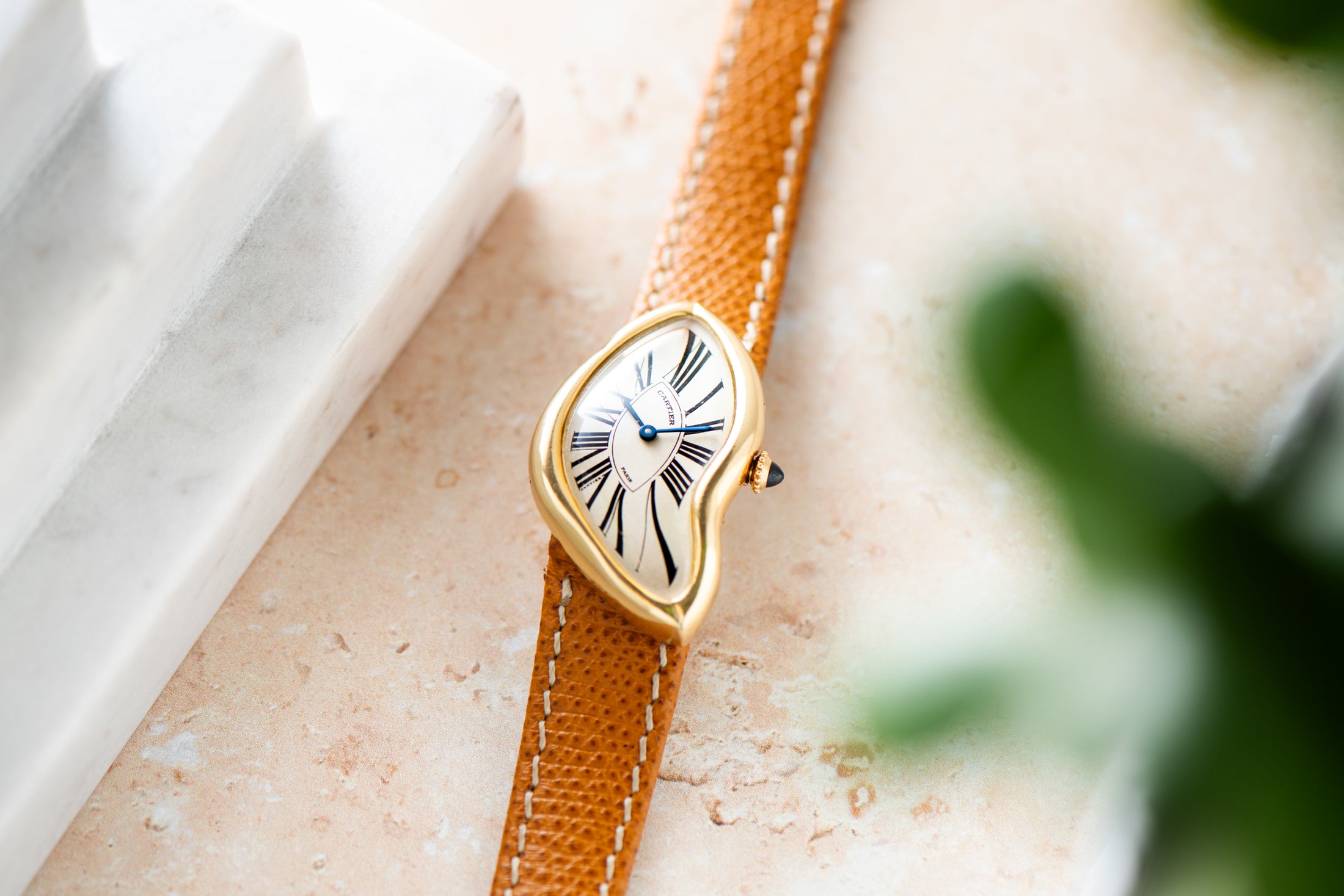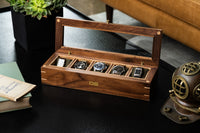Few timepieces exude class and understated elegance quite like the Cartier Tank, a dress watch that retains a magnetic pull upon both men and women more than a century after its debut during the First World War.
But if the Tank is ubiquitous — produced in myriad forms and readily available on both the primary and secondary markets — then its offbeat cousin, the Crash, is precisely the opposite: Rare as hen’s teeth, famously expensive, and thoroughly suffused with an air of mystery and legend.
What exactly is a Cartier Crash? For decades, no one outside of the famed French maison itself understood its origins. (In fact, it could be surmised that many within the company itself were in the dark as to the genesis of even this most famous and desirable of models.) Until recently, the lore went something like this:

Cartier London Maxi Oval - (Image by Monaco Legend Auction)
A client wearing a Cartier Maxi Oval (aka the Baignoire Allongée) was in a devastating car crash — one in which the ensuing fire permanently warped the ovular watch into the distended form we all know and love, hence the name “Crash.” (A bit macabre, yes?) Another, alternative history of the watch was simpler and even more plausible: The Crash’s shape, it was said, was inspired by surrealism — specifically by Salvador Dali and his famous 1931 piece The Persistence of Memory in which various pocket watches appear to have melted and hang across objects in the painting’s landscape, such as a tree branch.
Neither story — unfortunately, for the more imaginative among us — is true.

Jean-Jaques Cartier - (Image by Bellman's Fine Art Auctioneers)
Francesca Cartier Brickell, granddaughter of Jean-Jaques Cartier (who headed up the firm’s London branch), cleared the fog when she released her family history The Cartiers: The Untold Story of the Family Behind the Jewelry Empire in 2019. It turns out the genesis of the Crash was much more pedestrian and much less Biblical: Back in the 1960s — a golden age of horological design if ever there was one — Cartier clients were in search of new aesthetic directions inspired by the swinging atmosphere in the streets. Acclaimed British actor Stewart Granger, in particular, approached Jean-Jaques with a request for a watch “unlike any other.”

Cartier London New Bond Street Boutique - (Image by Cartier)
(If you’ve heard such a line before, it’s because the same sentiment was conveyed to Gérald Genta roughly a decade later, which led to the birth of the Royal Oak. But that’s a story for another day.)
Anyway, Jean-Jacques turned to one of his regular designers, Rupert Emmerson, and conceptualized a watch produced by “pinching the ends at a point and pulling a kink in the middle” of a Cartier Maxi Oval, such that it looked like it had been in a crash. Emmerson delivered several prototypes — one of which had an actual cracked crystal to make it appear extra crash-like. Mr. Cartier, however, who wished to retain his family business’s sense of elegance in each timepiece, felt that this was a bridge too far, and asked Emmerson to “tone it down.” Once he did, the design was green-lit.

Rupert Emmerson Cartier London sketch - (Image by Watch Insanity)
Jaeger-LeCoultre, with whom the firm had entered into a partnership in the 1920s, was consulted regarding a possible movement for the watch. At Wright & Davies, a Cartier-run workshop that produced components for the maison’s London creations, the metalworkers faced the challenging task of turning sheets of gold into the Crash’s strangely-shaped case. (While a standard Tank case might require 35-40 hours of work to complete, the Crash housings took much longer.) After this was done, the cases were given to Cartier London head watchmaker Eric Denton, who had the unenviable task of trying to fit case, movement, and dial together…
Which did not go well.
The problem was that the hand-painted, surrealist dial with its curvaceous Roman numerals didn’t take into account…well, geometry: As the hands made their slow revolution, they weren’t pointing at the correct numbers in real time, as these weren’t spaced correctly. Thus Denton had to take the first Crash apart and send the dial back to Emmerson for repainting. The second time, it should be noted, was not the charm — in fact, this process repeated itself several times before the timepiece functioned correctly. But the pursuit of art rarely goes according to plan — especially when said pursuit needs to coincide with the realities of physics.

Cartier Crash London - (Image by Sotheby's)
The year was 1967, and finally, the Crash had arrived. No two examples — which featured handmade cases and hand-painted dials — were the same. (Even the deployant buckles, which were made at Wright & Davies, were unique.) Roughly a dozen pieces were made during this time, one of which was offered to Stewart Grainger. The famed actor, having specifically requested an unusual watch, returned it a week later, confessing that it was too unusual and impractical!
Despite the incredibly low production run produced under Jean-Jaques, the watches carried a price tag of roughly $1,000, or something like $9,000 today. For reference, a modern Tank Louis in solid gold with a hand-wound movement — a lovely but run-of-the-mill Tank — retails for close to $13,000. Imagine that in 1967 one could’ve purchased a hand-made, unique watch for less than the cost of a modern production model. (We'll wait while you go dry your tears...) Jean-Jacques himself later said, “We should have charged more. Especially given how long each one took, tying up the workshop for an extended period. But you simply couldn’t charge too much then. There wasn’t that much wealth around. When I see what they go for today, oh my!”
By 1964, Jean-Jacques had sold Cartier London outside the family. In the 1980s, the maison produced a further run of Crash models, but by then, production had moved from London to Paris. Yet a third series of 400 pieces in yellow gold was produced in the 1990s. Auction results for all series are strong, with Paris-signed dials hammering for between $100,000-$300,000 as of the late 2010s and early 2020s. Original London pieces? One hammered in 2022 for an eye-watering $1.65 million.

Mechanical Legends Crash Skeleton Watch - (Image by Cartier)
In 2010, the maison released a skeletonized version powered by the manually-wound Cartier Calibre 9618 MC movement; later, in 2019, the Ref. WGCH0006 was introduced and sold by the London boutique. Hand-wound like the original model and powered by the Cartier Calibre 8971 MC, it closely resembles the original 1967 examples.
These days, it’s said that Cartier only produces roughly one Crash per month, and that each is spoken for by the time the watch is ready for delivery. Typically, it’s high-rolling clients such as Tyler the Creator and LeBron James who receive an allocation at retail, while social media is rife with celebrities and influences wearing them and singing their praises. Having begun its life as an obscure, low-production run, handmade experiment, the Crash is now bona fide horological luxury — and who can blame its fans?
Avant-garde, slightly strange, and totally cool, it’s one of the most interesting wristwatches in the world.













